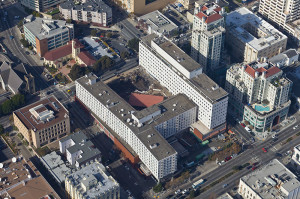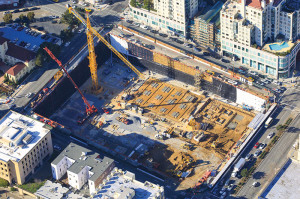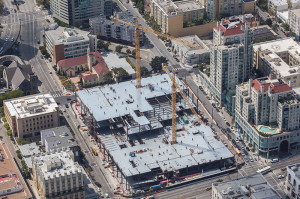Sutter Health and Integrated Project Delivery
Fifteen years ago, Sutter Health, a not-for-profit Northern California healthcare system with 24 acute care hospitals, decided that the traditional project delivery system was broken. Too often, projects ended badly for everyone, namely the owner, the construction team, and the design team. Between change orders, late projects, busted budgets, and litigation, there had to be a better way. Sutter started a journey to change the behavior of all the parties, itself included, by leading the way in the development of Integrated Project Delivery (IPD).
In 2004, Sutter Health formally announced this change in direction at a conference it hosted for its design and trade partners in the AEC community. Central to this launch were what came to be known as the Five Big Ideas, which act as the initial foundations of this new vision:
1) Optimize the Whole Project
2) Tightly Couple Learning with Action
3) A Project is a Network of Commitments
4) Increase the Relatedness of the Participants
5) Collaborate, Really Collaborate
In 2006, in support of this new vision, Sutter created and implemented a brand new contract form called the Integrated Form of Agreement that binds multiple project partners together under a single contract, single business deal with a single set of objectives.
During the period 2007 to 2015, using this vision and this contract, Sutter delivered several large hospital projects and multiple smaller clinic projects on time, on budget and most importantly, with no compromise to the clinical operational vision for these facilities. This was a total of $1.5 billion across fifteen separate projects. Currently, it has almost $3 billion in projects in progress using the same model of delivery. Much of this current investment is tied up in the single largest project in its history, the Van Ness & Geary Campus Hospital – and the subject of this article.
A primary component of the IPD approach is Lean Design and Construction, defined as “a production management-based approach to project delivery … that extends from the objectives of a lean production system – maximize value and minimize waste – and applies them in a new project delivery system.” The IPD project team strives to improve total project performance instead of reducing cost or increasing speed of any particular activity. (Lean Construction Institute)
The Seismic Legislative Background
As Sutter Health embarked on new ways to procure, design and construct healthcare projects, California was in the early stages of implementation of Senate Bill 1953, the seismic safety legislation for hospitals.. Immediately following the 1994 Northridge (M6.7) earthquake, older hospitals in the epicentral region were unable to provide acute care services. The SB 1953 legislation required all hospitals to be seismically strengthened, replaced or taken out of acute care service in accordance with a series of milestone dates between 2008 and 2030. By 2030, the legislation requires all hospitals to be able to provide immediate services after an earthquake. With the need to replace older facilities on several of its affiliate campuses, and with a large construction outlay anticipated, the impetus for Sutter Health to implement IPD on these projects was paramount.

Figure 1. Site before demolition.
With seismic issues identified in its older buildings at all four Sutter Health California Pacific Medical Center (Sutter CPMC) campuses in San Francisco, Sutter Health developed a $2 billion plan to consolidate a wide range of its services in a new hospital at Van Ness Avenue and Geary Boulevard. This site, covering an entire city block of over 100,000 square feet, had an existing 1960s era hotel and office building (Figure 1). The Van Ness and Geary Campus (VNGC) hospital, currently under construction, will open in the 1st quarter of 2019 as an 800,000 square foot, 274-bed hospital housed over 12 floors with an additional 230,000 square feet of underground parking (Figure 2).

Figure 2. New hospital, looking southwest from Van Ness Avenue.
Assembling the Team
With its goal to implement its IPD approach at the Van Ness and Geary campus, Sutter invited two teams to present their qualifications. Boldt Construction, an early developer and practitioner of Lean Construction, headquartered in Wisconsin, joined with Herrero Builders, a long-time San Francisco general contractor, and the San Francisco office of SmithGroupJJR (SGJJR), an architectural firm with decades of experience in California hospital planning and design. HerreroBoldt, in turn, selected Rosendin Electric Inc., and Southland Industries to join the IPD team, while SmithGroupJJR selected Degenkolb Engineers (Structural), Ted Jacob Engineering Group (Mechanical/Plumbing), and Silverman & Light (Electrical), to compete for the project based on hospital construction experience, experience working together, quality of work, and, perhaps most importantly, a willingness to join Sutter Health in doing things differently to achieve a different, better outcome than before.
Once Sutter Health selected the Herrero-Boldt team, Sutter Health brought their project management experts in IPD, together with the major construction team members and design professionals, to form the IPD environment. The Core Group, consisting of representatives from Sutter Health, Smith Group JJR, HerreroBoldt and Pankow Builders, signed the Sutter Health Integrated Form of Agreement, a three-way contract in which stakeholders are involved early to define project targets and to deliver the best value for the client. The IPD team agreed it would provide a project to meet the Client’s target cost, or Estimated Maximum price (EMP). The IPD team built into the EMP the cost of the work, a contingency pool, and the Risk/Reward pool. Seventeen Risk/Reward Members agreed to put 100% of their profit at risk in the Risk/Reward Pool and developed a contingency pool shared by the team, creating an environment that promotes collaboration to solve problems and implement cost-effective ideas. In this environment, any “fix” is funded from the contingency pool. By having their profits at risk, companies are energized to collaborate early on to avoid problems, even if that means crossing organizational boundaries to find solutions with partners in the team.
Each month, the Risk/Reward members meet to review the previous month’s financial billing report across the entire team. They track the actual cost of work versus the forecast cost of work and review changes to the forecast cost of work that affect the contingency pool available to cover such changes. Additionally, each month the Risk/Reward members review the risks (increased costs), and the rewards (cost savings) identified. With this monthly process involving all the Risk/Reward members, everyone has an eye on the financial aspects on an ongoing basis. There should be no surprises building up behind the scenes.
Project Start
The Sutter-HerreroBoldt-SGJJR IPD team started work in 2007 with a Validation Study phase to assess whether the program developed by CPMC could be designed and constructed with Sutter’s target budget. The entire team, design consultants side by side with the contractors, rapidly studied various options in each of the major disciplines, identifying the various tradeoffs in cost to achieve values for the owner.
Not too long after the HerreroBoldt-SGJJR team formed, one of its most important first tasks was the selection of the steel trade partner. The IPD team interviewed four steel fabricators and selected Herrick Steel to join the team. With all of the interviewed companies very experienced in steel construction, the primary differentiator in the selection was Herrick’s willingness to do things differently to achieve a better outcome.
Sutter Health has invested a large effort to make the VNGC project successful. The IPD team has created an environment to promote communication, collaboration, and learning, but how is IPD really different?
Starting with colocation in a downtown San Francisco office building, the IPD team members began the learning process to understand the interconnectedness of all the members and the benefits to working towards a common goal of success, measured first by the success of the project. Colocation of the project team companies brought everyone together, but it has taken a continually evolving effort to make it successful. Because of the many specialty teams involved, the natural inclination is to “work in silos” even though everyone’s work directly impacts and influences the IPD team success in achieving the ultimate goal. Thus, the project leaders were tasked with a big challenge of breaking this industry habit and opening the lines of communication.
“Having already completed a number of Sutter IPD projects, Herrick was extremely pleased to be again invited to the table early on the Van Ness and Geary project. One of the main differences this time around was the opportunity to begin our final design coordination and shop detailing activities more than six months earlier than usual. This allowed us to take two passes over the Tekla Structures model and shop drawings prior to going to fabrication. The majority of the work was completed on the first pass, with the second incorporating any last minute design or trade coordination packages. Between the two passes, we worked closely with Degenkolb and HerreroBoldt to prioritize Inquiries, Requests for Information (RFI’s), and Amended Construction Documents (ACD’s) to ensure these activities were closely tied to the structural steel fabrication schedule. This marked a shift in the standard Contractor / EOR / Fabrication relationship and behavior patterns. The end result was that all the fabrication packages were issued to the shop 100% complete and on time – something that is almost unheard of in the industry today.”
Wayne Morrison – Pre-Construction Manager – The Herrick Corporation
A main venue of communication and coordination is accomplished through weekly “Big Room” meetings where all key project participants, including Sutter’s IPD project managers, meet and discuss design, construction, and schedule. Everyone has the opportunity to have his or her voice heard and to weigh in on decisions. The team utilizes vPlanner software, a Last Planner® System to produce predictable, continuous work flow in planning, design, and construction, to review the prior week’s work and to plan or re-plan future work. Daily check-in meetings, usually for only 15 minutes, supplement the Big Room meetings, engaging main system leaders to exchange the work in progress, identify constraints, and “swarm” items that need to be addressed in the short-term.
Building Information Modeling, or BIM, provides the ultimate coordination, allows the team to ‘build’ the hospital in the virtual world before going to the site to build the real thing. All construction trades, architects, and engineers are required to design and model in BIM software, which allows for the creation of a centralized coordination model. The entire team can then observe each other’s work and adjust systems/components before they create real-world clashes.
“IPD is different because it breaks down the work into small batches, and details the work, workers and equipment required to complete the small batch of work (“level out the workflow”). When the team reviews the specific batch of work, the team includes all the people involved with the scopes of work, and details out their experiences to ensure we have eliminated as many obstacles as possible before the work starts. Part of the process for small work batches is using easily definable displays that communicate flow and sequence with the entire team in a visual format for all to follow.“
Joe McKeown – Concrete Senior Superintendent – Pankow Builders
Realizing information overload will likely happen when communicating with such a large team, the IPD team created special cluster groups to concentrate on their areas of expertise and filter necessary information to each other. The structural cluster team, primarily comprised of HerreroBoldt (GC), Degenkolb Engineers (structural engineer), The Herrick Corporation (structural steel contractor), and Pankow Builders (concrete contractor), was the first sub-group “out of the gate” to move from design completion into the construction phase. The other cluster groups included the Interiors Design, Exterior Design, and MEP Design Cluster Groups. Each of the cluster groups included members from both the design firms and the construction firms.
The primary structure received its approval and building permit from the California Office of Statewide Health and Planning Development (OSHPD) to start construction in May 2014. However, the design and preconstruction coordination by the other cluster groups continued over the next 14 months, creating a big challenge – approval of changes to the already-approved structural design documents that resulted from the ongoing design and coordination activities of the other cluster Groups. OSHPD must approve any material change to the permitted construction documents prior to construction. There is no “proceeding at risk” with unapproved construction documents. Ongoing changes to the structural design required an extensive review and approval process with OHSPD. The Structural Engineer of Record, the Architect, and the Contractor meet weekly with OSHPD staff to present material changes for approval in order to maintain continuous work flow in the field.
“At the VNGC project, one of our earliest missions was to establish a culture with OSHPD that was different. The IPD team knew that, in order to be successful, we needed to form a partnership, not only amongst ourselves, but also with OSHPD so that we could align ourselves to complete the common goal of a providing a state of the art hospital. With complete backing from Sutter Health, the IPD team defined new electronic submittal and review processes, loaned new hardware and software to the OSHPD reviewers, and implemented training specifically tailored to their day-to-day needs to bridge the gap between a new electronic review process and the old paper review process. This added a collaborative, real-time approach with comments/responses/and approval all occurring in the ethereal web-based cloud to make every issue transparent to all.”
Juan Restrepo, OSHPD & Commissioning Manager – HerreroBoldt

Figure 3. Start of foundation construction with excavation shoring in place.
Preliminary Results and Lessons Learned
The project is on schedule. Figure 3 shows the site nearing the excavation completion at one end of the site with simultaneous construction of the foundations at the other end. Figure 4 shows the site, with steel and metal deck erection at the end of August 2015. At that time, the project was 30 percent complete, with a forecast to be 50% complete by the end of Q2 in 2016. The contingency fund has held very constant over the last six months, with 75% of the fund remaining. Construction is proceeding rapidly with concrete placements occurring up to four days each week. Structural steel erection will be essentially complete by the end of 2015. The mechanical and plumbing trades are ramping up quickly with installation beginning at the bottom level, starting with preset embeds in the concrete decks to hand plumbing, ducts and electrical conduits.

Figure 4. Steel erection on-going.
With the model coordination that has been done to date, on-going construction has increased the team’s focus on coordination to an even higher level. There is nothing like continuous concrete placement to convince people that the design is complete, and there can be no more changes. Based on Sutter Health’s experience on previous projects, the leadership has been direct and adamant that the IPD team will coordinate the design using the BIM models, the contractors will build to the coordinated BIM models, and the results will be checked using LIDAR to scan the as-built construction to compare to the BIM model. Coordination at the interfaces between interior and exterior construction has been the most challenging, because the interfaces involve so many disciplines.
Conclusions
Sutter implemented the Integrated Project Delivery system to create a team environment amongst the owner, design consultants, and construction team. A target was set with open understanding of the team’s goals and requirements. As demonstrated in this article, this radical change requires constant effort to alter behaviors, try new techniques, and promote continual learning. Having the owner and all Risk/Reward Members in a collaborative environment is the key to the success of IPD; people that are willing to embrace the IPD environment while making sure not to lose sight of the design and construction methodologies that have worked in the past, but that can be improved upon and refined in the spirit of creating value and reducing project risk.
“The IPD culture is one combining old school tactics with new age technology. The IPD team is a continuous improvement environment with employees with 20 plus years engaging with young energetic engineers who take the knowledge of their managers and streamline it into a leaner, more productive solution. There is no single leader who makes all the decisions, but rather a group of peers educating each other and working together to make it the best project possible.”
Joe McKeown – Concrete Senior Superintendent – Pankow Builders
As the AEC industry goes through a fundamental transformation, Sutter Health and the IPD Team chose to embrace this change and to create a collaborative and innovative project team to design and build VNGC. Implementation of collaborative delivery process and BIM technologies offered a unique environment to AEC professionals and created a high performing team.▪
